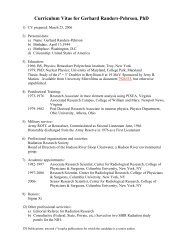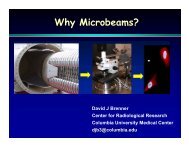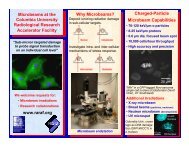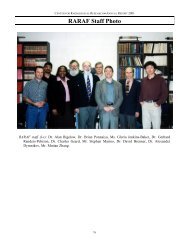LASER ION SOURCE DEVELOPMENT FOR THE - raraf
LASER ION SOURCE DEVELOPMENT FOR THE - raraf
LASER ION SOURCE DEVELOPMENT FOR THE - raraf
Create successful ePaper yourself
Turn your PDF publications into a flip-book with our unique Google optimized e-Paper software.
CENTER <strong>FOR</strong> RADIOLOGICAL RESEARCH • ANNUAL REPORT 2004<br />
the Van de Graaff, which could take up to a month for modifications<br />
to the terminal and testing, because the accelerator<br />
will be decommissioned at the end of April.<br />
Secondary emission ion microscope<br />
As we improve the spatial characteristics of the microbeam<br />
system, it becomes increasingly important to be<br />
able to assess the beam quality in order to adjust the system<br />
to its optimum capabilities. A secondary electron ion microscope<br />
(SEIM) has been designed and is currently being constructed.<br />
This device will enable us to measure the beam<br />
profile and position in real time with sub-micron resolution<br />
and sensitivity to single ions (1−5 MeV protons, as well as<br />
heavier ions). The SEIM design was inspired by the technique<br />
of photoelectron microscopy (PEM) and we gratefully<br />
acknowledge the advice of a world expert in PEM, Dr.<br />
Gertrude Rempfer, in finalizing our design. The SEIM is<br />
based on secondary electron emission (SEE) by a film on<br />
which the ions in the beam are incident. The ejected electrons<br />
are focused to form a magnified image on an imageintensified<br />
CCD. In order to overcome the chromatic and<br />
spherical aberrations inherent in the electrostatic lens and<br />
provide a more compact instrument, the electrons are bent<br />
by a 45º angle, reflected by an electrostatic mirror and bent<br />
by an additional 45º before reaching the detector. This<br />
“folded” design of the SEIM is a novel one, developed at<br />
RARAF. Calculations indicate a magnification of ~500 can<br />
be achieved, yielding a resolution of 0.1−0.2 µm.<br />
We have built an “unfolded” SEIM, consisting of the<br />
electrostatic lens and the electron detector but without the<br />
magnet and mirror, in order to test the lens properties. For<br />
this version, simulations have shown that both the resolution<br />
and magnification are 10−20 times inferior to the folded<br />
SEIM. For testing and calibration purposes the SEE foil was<br />
replaced with a quartz window on which a micron scale pattern<br />
of aluminum was evaporated. The pattern was illuminated<br />
with low intensity UV light and the resulting photoelectrons<br />
were imaged, similar to a photoelectron microscope.<br />
In a sample image based on ~200,000 electrons the<br />
width of the spot edge allows us to estimate the SEIM resolution<br />
at 4.3 µm RMS, in good agreement with the prediction<br />
of 4−5µm made by simulations. The predicted magnification<br />
(16x) is also in good agreement with the measured<br />
value of 20x.<br />
The SAM would also be useful for groups that desire to<br />
perform microbeam experiments at their home institutions<br />
but lack an appropriate accelerator. It is estimated that a<br />
complete SAM system, including the microscope, could be<br />
built for ~$100k.<br />
Non-scattering particle detector<br />
To irradiate thick samples, such as model tissue systems<br />
or oocytes, or to use particles with very short ranges, such as<br />
the heavy ions from the laser ion source, a completely nonscattering<br />
upstream particle detector is necessary. A novel<br />
particle detector has been designed on the basis of a long<br />
series of inductive cells coupled together into a delay line.<br />
The Lumped Delay Line Detector (LD 2 ) will consist of 300<br />
silver cylinders 3 mm long with a 2.2 mm inside diameter<br />
72<br />
connected by inductors and capacitively coupled to ground.<br />
The cylinders are glued to a semi-cylindrical tube of dielectric<br />
material 1 m long for mechanical support. The dielectric<br />
has a semi-cylindrical metal tube around it that can be rotated<br />
about its axis to adjust the capacitance. If the individual<br />
segment delays are set (by adjustment of the capacitance)<br />
such that the propagation velocity of the pulse equals the<br />
projectile velocity, the pulses induced in all segments will<br />
add coherently, giving a fast electron pulse at one end of the<br />
delay line that is 150 times larger than the charge induced on<br />
a single cylinder. This easily detectable charge of at least<br />
150 electrons will be amplified to provide the detection<br />
pulse for the particle counter. The surface-mount inductors<br />
have been purchased. The silver cylinders originally purchased<br />
proved to be too eccentric and badly finished. Silver<br />
tubing has been purchased from which our shop will machine<br />
the cylinders. The rest of the detector parts have been<br />
designed and await machining. Testing of the detector will<br />
probably not begin until we have the new accelerator operational.<br />
It is anticipated that this detector will become the<br />
standard detector for all the irradiations on the new microbeam<br />
facility.<br />
Advanced imaging systems<br />
Development continued on new imaging techniques to<br />
view cells without using stain and to obtain threedimensional<br />
images of unstained cells. Two different techniques<br />
are being investigated: phase-shifted interference<br />
microscopy and quantitative non-interference phase microscopy<br />
(QPm).<br />
In phase-shifted interferometry images are obtained with<br />
an immersion Mirau interferometric objective in a sequence<br />
of three sub-wavelength path differences (phase shifts) between<br />
the sample and the lens. For this technique, it is important<br />
that the substrate for the cells be optically flat. The<br />
combined images can be used to produce a topographic image<br />
by solving for the phase shifts at each point. The essence<br />
of the algorithm for determining these phase shifts is to<br />
solve for three variables with an over-determined system of<br />
four equations. Results so far are encouraging. It has not yet<br />
been determined whether the cells will have to be on a reflective<br />
surface. The Mirau lens has been purchased and the<br />
immersion system has been designed, with assistance from<br />
Chun-Che Peng, one of the high school students.<br />
The other method being investigated is a relatively new<br />
technique that can generate phase images and phaseamplitude<br />
images using a standard microscope. To obtain a<br />
quantitative phase image, an in-focus image and very<br />
slightly positively and negatively defocused images are collected.<br />
The resulting data can be used to yield the phase distribution<br />
by Fourier-transform methods. Test images sent to<br />
the software manufacturer yielded surprisingly good resultant<br />
images. We are evaluating a trial copy of the Fourier<br />
transform-based software for generating phase images or<br />
phase-amplitude images from the three microscope images.<br />
Both of these techniques require rapid automated motion<br />
in the X-Y plane for locating the cells as well as in Z for<br />
changing the focal plane. In the case of immersion-based<br />
Mirau interferometry, the precision must be on the order of







